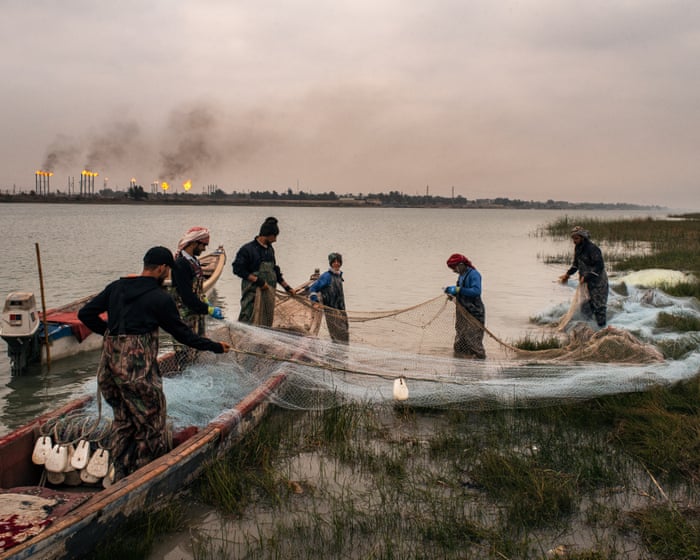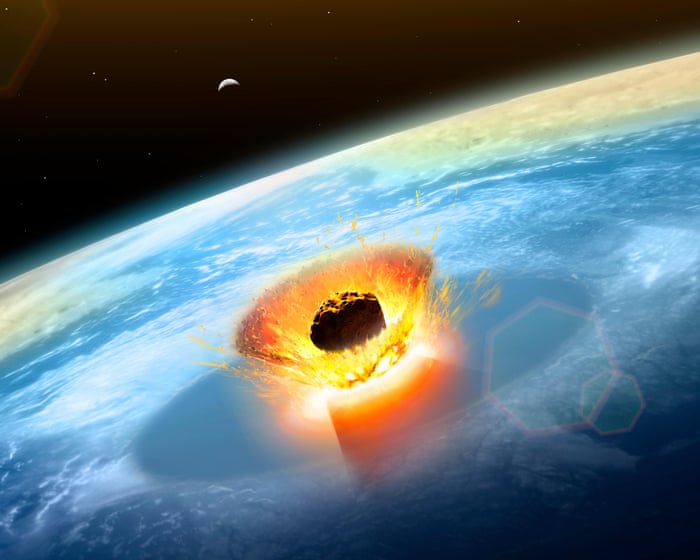At dawn, a mist hangs over the canals of Hawizeh, where the sky and water blend together like a mirror. In the back of a narrow wooden boat, 23-year-old Mustafa Hashim watches the shallow marshes, turning off the motor and switching to a pole to avoid getting stuck in tangled roots or thick mud.
It takes him about thirty minutes to navigate the shrinking marshes to reach Um al-Nea’aj, once a lively lake filled with boats and birds. Now, the water is barely half a meter deep.
“Two years ago, this place was full of families and fishermen,” Mustafa says, leaning over the side of the boat. “You could hear laughter, the sound of fish jumping. Now, there’s nothing.”
In the distance, flames from the Halfaya oilfield flicker on the horizon.
Iraq’s southern wetlands—known as the Mesopotamian marshes—are among the world’s most threatened ecosystems. Some believe this was once the location of the biblical Garden of Eden. Recognized as a UNESCO World Heritage Site in 2016 and protected since 2007 under the Ramsar Convention, the marshes once stretched nearly 120 miles from Nasiriya to Basra, forming a vast and thriving water world.
But beneath the surface lies another kind of treasure: oil. Three major oilfields—Halfaya, Huwaiza, and Majnoon—overlap with the protected area. Majnoon, whose name means “crazy” in Arabic, is one of the world’s largest oilfields, with estimated reserves of up to 38 billion barrels.
Extracting that oil requires enormous amounts of water. In a land already suffering from drought and desertification, the marshes are drying up.
Mustafa’s grandfather, 87-year-old Kasid Wanis, once traveled by boat from Hawizeh to Basra—about 70 miles—using only a pole and his memory of the waterways. “We didn’t know what cars were. We didn’t need them. We were people of the water,” he says.
His son Hashim, Mustafa’s 41-year-old father, grew up fishing here. But four years ago, he put away his nets for good. “There’s not enough water to survive,” he says quietly.
Oil is Iraq’s economic backbone, making up over 95% of its exports and 69% of its GDP. The country is the world’s sixth-largest crude producer, and the fate of the Hawizeh marshes is tied to the oil industry. Since Russia’s invasion of Ukraine in 2022, Europe has turned to Iraq as a key oil supplier.
The link between oil extraction and water loss is clear and destructive. The Halfaya oilfield—partly owned by French energy company TotalEnergies—is operated by a consortium led by PetroChina.
Covering an area three times the size of Paris, it has 300 wells, three oil-processing plants, a water-treatment facility, and even its own airport to shuttle foreign workers. It’s PetroChina’s biggest overseas project.
About ten years ago, soon after PetroChina began operations here, six water-pumping stations were built along the Tigris River—the lifeline of the marshes.
Every day, they draw about 60,000 cubic meters of water—enough for a mid-sized city—diverting it to the oilfields instead.The water is injected into wells to boost oil extraction—a common practice throughout the region.
The pumping stations rely on already shrinking water reserves. Upstream dams in Turkey and Iraq’s Kurdish region have cut water flow to southern Iraq by over 50% since the 1970s. Iranian dams on the Karkheh River, which feeds the Hawizeh marshes, have also reduced the area’s water supply. Now, locals say this industrial oil complex is destroying their environment and way of life.
These days, Hashim is less concerned about declining fish stocks than about military checkpoints. The canals that once stretched deep into the wetlands are now blocked and guarded. Armed soldiers control access, forcing local fishermen and buffalo herders to surrender their ID cards to enter.
The marshes have turned into a militarized zone. Authorities claim the increased police and military presence is meant to stop smuggling and secure the nearby Iranian border, just miles away. But residents say it also silences local protests.
“The occupation follows the oil,” Mustafa says. “They want to separate us from our land so they can exploit it without resistance.”
A water buffalo carcass lies where Basra’s northern marshes once thrived. They dried up after a pumping station was built to supply water to oilfields operated by the Italian company ENI.
As the marshes vanished, Mustafa did what many others have been forced to do—he joined the very industry he blames for their destruction. In 2023, he and his father worked as subcontractors for PetroChina. “I saw it up close,” he says. “They call it development, but it’s just destruction disguised as progress.”
By summer, he had quit. That same year, drought peaked, and protests erupted across the region. Mustafa joined in, organizing blockades on oilfield access roads. “At first, I told Mustafa to stop,” Hashim says. “But then he made me see—this is political, and we can’t stay silent.”
Beyond its water consumption, oil extraction in the region has been linked to severe pollution. “This economy is literally killing people,” says Majid al-Saadi, director of Maysan province’s agriculture department. In late 2024, Saadi and his team compiled a confidential government report on the effects of oil extraction.
The report, seen by the Guardian, documents dangerous levels of hydrocarbons, heavy metals, and chemicals in drinking water, along with the collapse of local agriculture. “This isn’t just pollution—it’s theft,” Saadi says.
Wastewater and polluted foam flow into Basra’s Ashaar canal, near the Shatt al-Arab River. Once called the “Venice of the Middle East,” Basra’s canals are now filled with sewage.
In early 2025, Saadi submitted the report to Iraq’s environment ministry. Officials promised to discuss it with the oil ministry, but he doubts any action will be taken.
Meanwhile, oilfield expansion continues. Leaked photos and videos, verified by the Guardian, show excavators, pipelines, and workers digging directly into the protected zone—where the new Huwaiza oilfield is being developed.
Satellite analysis by Placemarks, an independent geoanalysis studio, confirms the exploration.
Fish sold in Nahr Bin Omar no longer come from the nearby Shatt al-Arab River, which hasn’t yielded enough catch for years. Instead, they’re sourced from the sea or fish farms.
A February 2023 contract between Iraq’s state-owned Maysan Oil Company…The partnership between PetroChina and China’s Geo-Jade Petroleum paved the way for developing the oilfield, but new drilling would violate Ramsar wetland protections. However, the agreement isn’t legally binding and relies on voluntary compliance by governments.
Iraq’s oil and environment ministries didn’t respond to requests for comment. In July, the interior ministry’s security agency posted on social media that environmental police had inspected the Hor al-Huwaiza area to monitor potential violations by oil companies. They found the marsh completely dried up, with no active drilling or oil waste disposal, but noted excavations by local contractors working with Geo-Jade for future oil exploration.
The Basra water resources directorate has warned of a growing humanitarian crisis due to water shortages, pollution, and rising toxicity. Jassem Falahi, an environment ministry official, previously told AFP that protected status doesn’t block development projects but stressed that investments must follow strict conditions to avoid harming biodiversity.
TotalEnergies, which holds a 22.8% stake in the Halfaya oilfield, stated it isn’t the operator and directed questions to PetroChina. Neither PetroChina nor GeoJade responded to requests for comment.
Nearby, fishermen continue working illegally during breeding seasons, selling their catch along the highway for about €1 per kilogram. UNESCO expressed deep concern over the threat oil and gas projects pose to the wetlands’ fragile ecosystem.
With livelihoods disappearing, many residents have abandoned their homes. Protests erupted three months ago near the Halfaya oilfield, with demonstrators opposing new drilling permits. “This isn’t just about today,” said Mustafa, a local resident. “We’re fighting so future generations can know the wetlands our ancestors protected for millennia.”
As Iraq ramps up oil production amid worsening water shortages, Basra’s Human Rights Commission has called for a state of emergency, warning of an impending disaster from pollution and toxicity.
For those still in the marshes, the struggle continues—over land, water, and survival. “The government and companies treat us like a cake to be divided,” Mustafa said. “They see these waters as a business opportunity. For us, it’s life.”
This investigation was supported by Journalismfund Europe and IJ4EU.
FAQS
### **FAQs About “Destruction Masquerading as Progress”: Iraq’s Ancient Wetlands Drying Up Due to Oil Industry**
#### **Basic Questions**
**1. What are Iraq’s ancient wetlands?**
Iraq’s Mesopotamian Marshes are one of the world’s oldest wetland ecosystems, home to unique wildlife and ancient communities like the Marsh Arabs.
**2. Why are the wetlands drying up?**
The oil industry and upstream dam projects are draining water from the marshes, causing severe drought and environmental damage.
**3. How does the oil industry contribute to the destruction?**
Oil extraction requires large amounts of water, and industrial waste pollutes the marshes, making the water unusable for wildlife and people.
**4. Who lives in these wetlands?**
Indigenous Marsh Arabs (Maʻdān) have lived here for thousands of years, relying on fishing, agriculture, and buffalo herding.
**5. Why should we care about these wetlands?**
They are a UNESCO World Heritage Site, support biodiversity, and hold cultural significance for Iraq’s history.
—
#### **Environmental & Economic Impact**
**6. How does wetland destruction affect wildlife?**
Many species, including migratory birds and endangered fish, lose their habitat, leading to ecological collapse.
**7. Does this impact Iraq’s water supply?**
Yes, draining the marshes worsens Iraq’s water scarcity, affecting drinking water and farming downstream.
**8. Are there economic benefits to the oil industry’s actions?**
Short-term profits come from oil, but long-term losses include destroyed livelihoods, lost tourism, and costly environmental damage.
**9. What role do dams play in this crisis?**
Upstream dams in Turkey, Iran, and Syria reduce water flow into Iraq, worsening the marshes’ decline.
—
#### **Political & Social Issues**
**10. Is the Iraqi government doing anything to protect the wetlands?**
Efforts are weak due to corruption, oil industry influence, and competing water needs. Some restoration projects exist but face challenges.
**11. How does this affect Marsh Arab communities?**
Many are forced to leave as their land turns to desert, losing their traditional way of life.
**12. Have the wetlands been destroyed before?**
Yes, Saddam Hussein drained them in the 1990s as punishment for rebell




